I remember the first time I left the big cities and found a tiny cave village clinging to a sunburnt ravine. The silence there felt honest, and the views made me slow down. I map my trip so each stop shows a different layer of the country’s history — Roman ruins, Moorish walls, and quirky modern architecture that locals still use today.
This guide walks you through desert coasts, gorge boardwalks, cave homes, and ancient sites. I choose places for character and low crowds, and I plan days to balance nature walks with small-town meals and respectful interactions with people who live there.

I also share practical notes: when I rent a car, when regional trains work, and how I link nearby locations into a flexible route. Along the way I stick to conservation-minded habits so these spots stay real for future visitors.
Key Takeaways
- I focus on lesser-known sites beyond major cities that reveal deep history and strange architecture.
- Each place is chosen for character, minimal crowds, and memorable views.
- My itinerary balances outdoor walks, local eateries, and respectful photography.
- I offer logistics tips: rental car vs. regional trains and how to cluster locations by area.
- Conservation-minded habits and timing (sunrise, late-afternoon shade) help preserve these places.
Why I chase Spain’s hidden corners right now
Lately I choose quiet corners because they give a clearer view of how local life actually works.
This is the right time to nudge tourists away from crowded museums and into small towns that welcome respectful visitors. I plan each trip around shoulder-season time windows so light is better and encounters with local people feel real.
Staying longer in a village changes the pace. I sit in corner bars, buy bread from family-run bakeries, and notice details in stonework, water channels, and terrace farming.
I favor public transport when it links towns cleanly. I rent a car only where distances or dispersed sites make it necessary. That mix helps me limit strain on fragile places by avoiding peak times and staying on marked paths.
“Slowing down turns a stop on a map into a place that lingers in your memory.”
- Choose lodgings that keep money local: casas rurales, small inns, cave homes.
- Pack out trash, respect wildlife, and leave room for serendipity—markets, viewpoints, and festivals.
- Balance big cities with quieter stops to see the country’s fuller story.
| Choice | Benefit | When I use it |
|---|---|---|
| Public transport | Lower impact, local interaction | Short distances between towns |
| Rental car | Access to dispersed sites | Remote regions, flexible schedule |
| Local lodging | Money stays in community | Casas rurales, inns, cave homes |
| Slow pace | Deeper views and conversations | Shoulder-season days, mornings and late afternoons |
Valencia Province mountain gems: Chelva, Chulilla, and Buñol beyond Tomatina
I begin my day in Valencia province by chasing narrow streets and sudden canyon views. I start in Chelva’s old town, where narrow streets thread Arabic and Jewish quarters. I wander courtyards and arches and linger over the layered architecture.
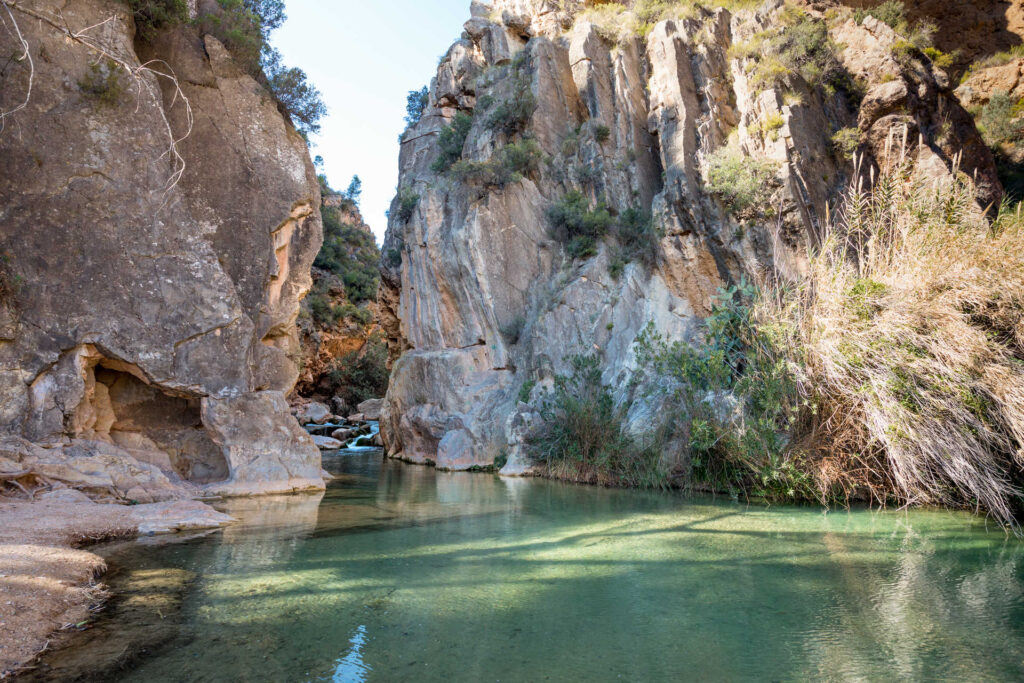
Then I hike. Chelva’s Ruta del Agua and the Aqueducto de la Peña Cortada mix boardwalks, short tunnels, and a Roman span that opens to wide gorge views. The route feels ancient and alive.
Hanging bridges and gorge walking in Chulilla
Chulilla’s Ruta de los Puentes Colgantes crosses a deep canyon via suspension bridges. I time the day to hit the canyon shade and decide whether to follow the easy way along the water or climb for higher overlooks.
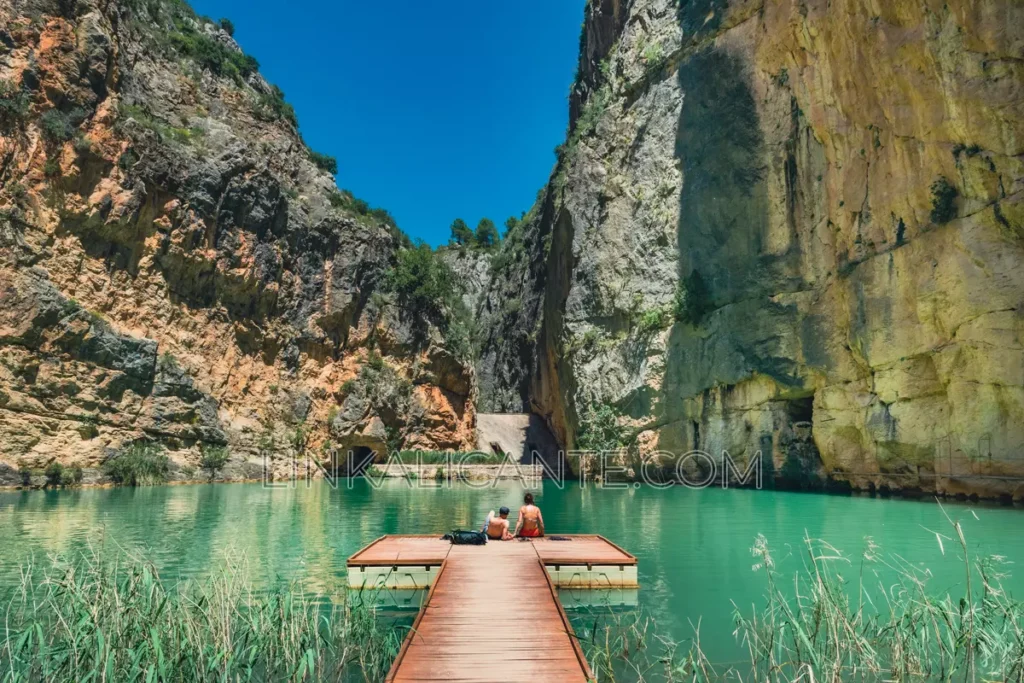
Buñol by train: castle, art, and waterfalls
I take the train from Valencia to Buñol, stroll up to the castle grounds, then hunt for street art before the Ruta del Agua. The Cueva del Turche and Cueva de las Palomas waterfalls make a perfect midday cool-off.
- I plan an hour-by-hour loop: early hike, pause at a vantage point for photos, then town refreshment.
- If I stack these towns in two days I use a car to link hikes and maximize views.
- Things I pack: trail runners with grip, a headlamp for short tunnels, and light snacks for ridge stops.
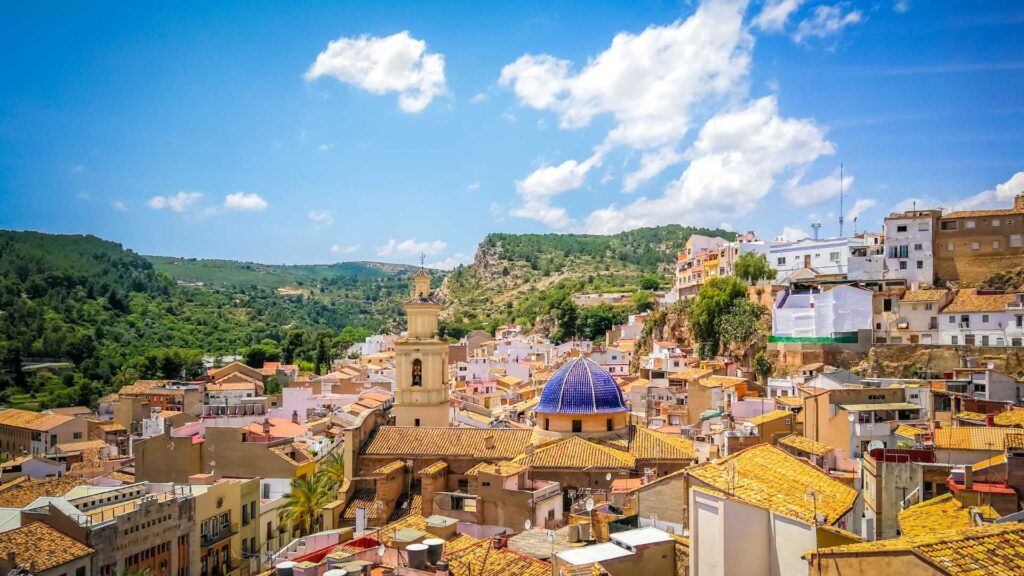
“Slowing down here turns compact streets into a slow museum of stone, door knockers, and fountain tiles.”
This trio shows Valencia Province’s gorge country: quiet, dramatic, and built for walkers who want small-town charm and big views.
Desert, volcano rock, and empty beaches in Cabo de Gata Natural Park
Driving into the park, I found the landscape stripped down to wind, rock, and a long coastal horizon.
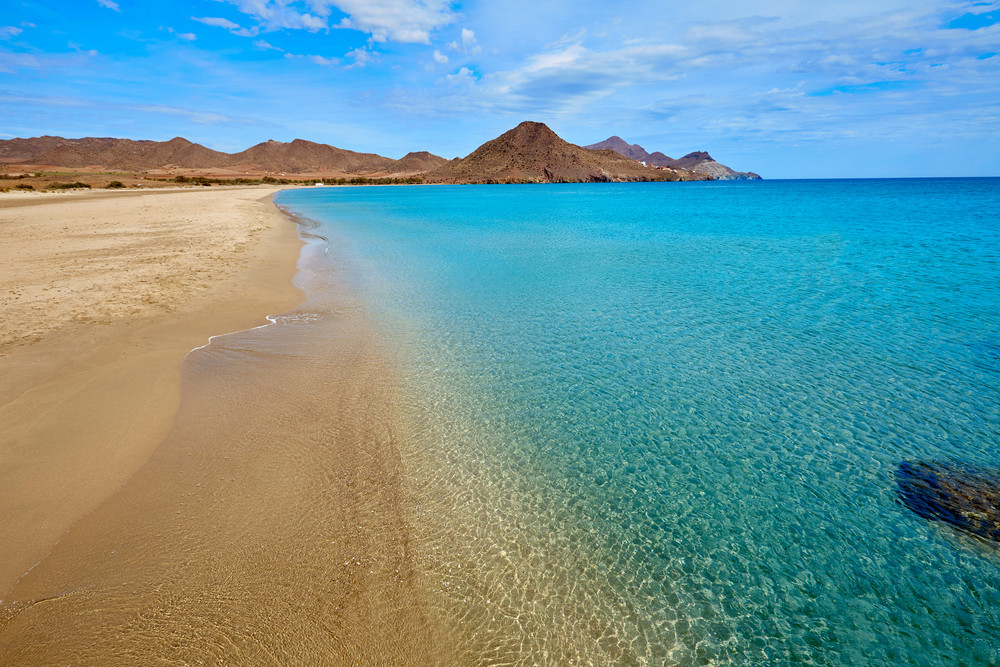
Los Genoveses and Monsúl: sun, sand, and cinematic rock formations
The first sight is volcanic cliffs meeting turquoise water. Each bay curves differently, changing the wind and the views.
I plan a full day for Los Genoveses and Monsúl to photograph lava flows and wind-sculpted forms as afternoon light deepens the silhouettes.
Hippie coves and clothing-optional culture at Cala de San Pedro
Cala de San Pedro feels like a small community tucked into a cove. Camping is tolerated, and the norm is to pack in and pack out.
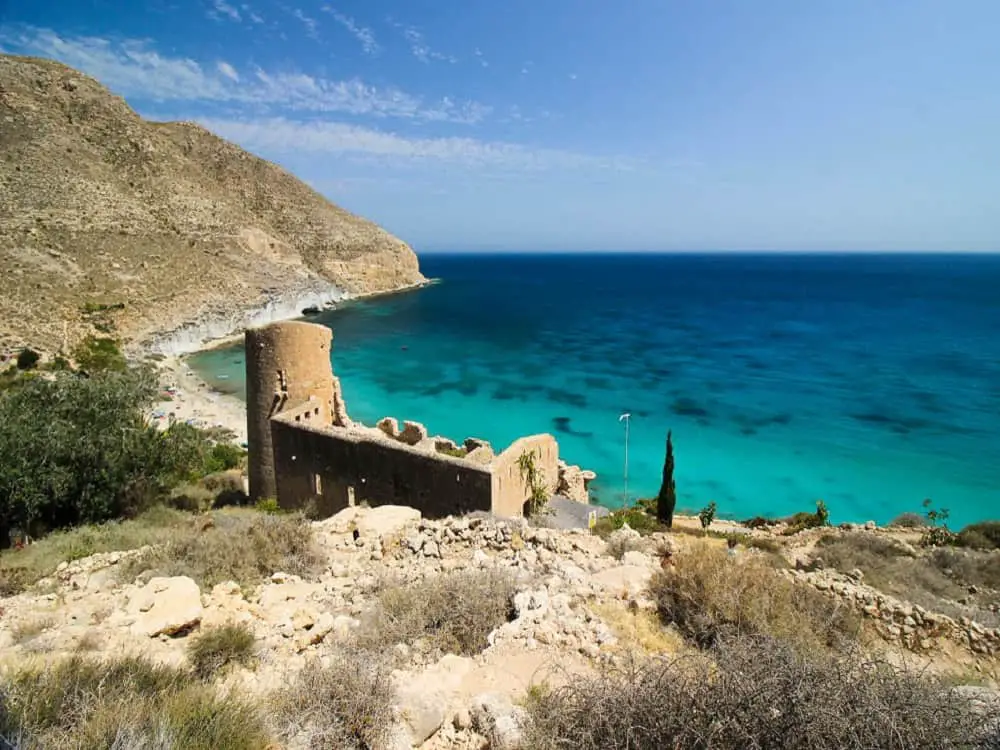
I respect local customs and leave no trace so this location stays as it is.
How I get around: why I always rent a car in this vast area
The park is wide and dispersed. A single car unlocks unpaved turns, quiet trailheads, and secluded coves buses don’t reach.
- Bring water, shade, and sturdy shoes for basalt slabs and sandy climbs.
- Arrive early for easier parking at popular beachheads.
- Watch a few quiet pullouts to see fishing boats and world-class coastal calm.
“This is elemental coastline—desert flora, starlit nights, and geology that keeps me returning.”
Minas de Ríotinto: where a red river tells a story of time
The river’s impossible red pulled me out of the car and toward the old tracks. The color comes from copper and iron in the water, a visible record of geological time that reads like a rusted map.
I spend a slow dayboarding the heritage train that runs along former ore routes. It stops at pullouts where the opaque surface and sky create surreal views for a photo.
Train into another world: stopping for unreal views of copper-rich water
I step off at each river viewpoint to watch reflections change with light. Cloud breaks make the tonal contrast pop, so I plan shots around shifting skies.
In town I visit the mining museum to link the landscape to human history. The exhibits put miners’ lives and machinery into context and make the red channel feel lived-in, not just seen.
- I usually drive in by car for flexibility and pair this area with Aracena’s caves and castle later in the day.
- Pack snacks and water: services near track stops are limited.
- Wear darker clothes—iron-rich dust can stain fabric.
“The red river made me rethink the region’s mining past and its environmental legacy.”
Guadix cave houses and the End of the World viewpoint
The Barrio de las Cuevas feels like a neighborhood folded into the earth, each doorway a cool, lived-in cave. I wander narrow lanes where white chimney pots dot the hills and carved rooms stay cool all day.
I spend time at the cathedral, a Roman Catholic church finished across the 16th–18th century span, admiring façades and the layered architecture that marks each century of change.
I climb to the Alcazaba to read Moorish lines in stone and watch light move over the valley. From this location the scale of the badlands becomes clear, and the Mirador del Fin del Mundo opens wide views over ochre chimneys and carved homes.
I recommend using a car to link an easy one-day loop: viewpoint, cathedral, and a cave-museum stop. Pause for a photo when cloud and wind catch the ridge; the light changes fast.
- Book a guided visit rather than peeking into private dwellings as the respectful way to tour cave homes.
- Look for local ceramics that echo earth tones and bring a small purchase to support artisans.
“Guadix blends land and home in a way that feels both ancient and alive.”
El Saltillo, Málaga: the quieter “other Caminito del Rey”
I start in Canillas de Aceituno, climbing cobbled steps toward the ridge until the route splits from La Maroma and hugs the cliff edge.
The way follows old water pipes along narrow ledges, then crosses two suspension bridges before finishing near a small waterfall. There is no entrance fee and no helmets required, but the exposure is real—this is not for anyone with vertigo.
I treat it as a half‑day outing. Pack poles for slanted sections and keep your hands free. A car is needed to reach the trailhead early, before heat and parking fill the area.
I time my trip in hour‑by‑hour chunks: village start, ridge climb, cliffside hour, then a rest by the waterfall for cool mist and long views. After the walk I explore the streets, grab a cold drink, and buy local olives.
- I pair El Saltillo with nearby white‑village lookouts for a scenic loop.
- The old water channel ledges give the hike a steady rhythm that feels both ancient and urgent.
“El Saltillo is one of my favorite gems when I want cliff drama without the crowds.”
Castril and the Cerrada boardwalk: tunnels, a suspension bridge, and a cliffside town
Castril perches on a rocky spur where steep lanes lead up to castle ruins and sudden viewpoints. I park below the cliffside town and slowly climb the cobbled streets to reach the upper miradores.
The Sendero de la Cerrada del Río Castril begins cool in the morning. I walk the river boardwalk, cross a suspension bridge, and slide through a short tunnel to the restored mill-turned-restaurant.
My way back is often the dirt road through olive groves to vary the scenery. The old town lanes reward slow exploration; windows framed by timber and tilework make wandering feel like discovery.
I keep this as a relaxed day: one gorge walk, one meal, and time for a gelato in the square. Access is best by car, and I suggest a spot on the edge of town for sunset light over the river bend.

“The mill’s rustic menu and a cold drink by the water are the kind of small pleasures that make this place memorable.”
| Feature | Best time | What I pack |
|---|---|---|
| Boardwalk & bridge | Morning | Light hiking shoes, water |
| Mill-turned-restaurant | Midday lunch | Cash or card, camera |
| Return route | Afternoon | Sun hat, comfortable pace |
| Old town exploration | Evening | Time to wander, gelato stop |
Sanabria Lake Natural Park: glacier lagoons, stone villages, and starry nights
A wide glacial basin and quiet slate villages make Sanabria feel like a place frozen between sky and stone.
The location holds the largest glacial lake on the Iberian Peninsula and a string of smaller lagoons. I base myself near the lake for a couple of days to catch still mornings and clear-night stargazing.
I walk easy lakeside paths for mirror reflections and climb higher ridges for long views over the glacial basin. A car is the usual way to link trailheads and stone villages across this broad area.
I visit Puebla de Sanabria to feel at home among slate roofs, plazas, and a castle viewpoint. I buy mountain cheeses and honey from a tiny shop before heading back to camp.
Practical time notes: this place sits far from the nearest big city, so I stock up before entering the park. There are plenty of short loops that balance effort and scenery.
“Shadows sweep across the water late in the day and the air cools fast—perfect for a picnic by a quiet lagoon.”
| Feature | Best time | Why I choose it |
|---|---|---|
| Base near lake | 2–3 days | Stargazing, still mornings |
| Short lakeside loops | Morning or late afternoon | Reflections, low effort |
| High ridges | Midday for views | Panorama of glacial basin |
| Puebla de Sanabria visit | Afternoon | Slate roofs, shops, castle |
Cazorla, Segura y Las Villas: Spain’s largest protected area with wildlife on the trails
A ring of pine ridges, rivers, and century-old paths makes this area feel like a vast outdoor museum of ecology and human traces. Covering more than 2,000 square kilometers, the park unfurls across valleys where deer, wild boar, and fox are common sights.
I base myself in Cazorla town to tap into day hikes that thread old forest routes. From town I walk to nearby trails and then use a car when I need to reach remote trailheads or higher viewpoints.
Base in Cazorla town for day hikes and century-old forest paths
I plan a simple rotation: one ridge for long views, one river route, and one shaded mixed-forest loop. I weave local history into hikes by pausing at lookout ruins and water channels.
- I aim for wildlife sightings early in the morning.
- I spend time at waterfalls and ravines for a midday pause.
- I add an easy evening walk to stretch after a big ascent.
“The park’s scale rewards patience — more days here mean more quiet places to find.”
| What I do | Best time | Why |
|---|---|---|
| Base in town | Multiple days | Easy access to trails and services |
| Use a car | Morning or midday | Reach remote trailheads and viewpoints |
| Rotate hikes | Daily | Variety of habitats and wildlife |
Carmona’s Roman gates and Moorish walls a short hop from Seville
A short hop from Seville, Carmona unfolds like a pocket museum of gates, towers, and sun-warmed plazas.
I reach the town from the capital in about a half-hour each way, so it fits neatly into a compact day without rushing.
Start at Puerta de Sevilla. I climb to the Tower of Gold rooftop for broad views over tiled roofs, olive fields, and narrow streets. From there the Roman gate reads like a page in living history.
Puerta de Sevilla, the Alcázar, and rooftop views from the Tower of Gold
I trace Roman lines that blend into Moorish walls and small castle courtyards. The Alcázar’s stones reveal layered architecture up close.
Gothic church moments: Iglesia de Santa María de la Asunción
I step into the old town plazas for a coffee, then visit the 15th-century church and compare its Gothic detail to Seville’s cathedral, but on a human scale.
- I reach Carmona from the capital in about an hour round-trip—perfect for a packed hour of sights.
- I time a rooftop moment for golden light, then wander tiled corners and balconies dressed in flowers.
- Late lunch and a brief siesta keep the small-town rhythm intact.
“Carmona feels at once ancient and neighborly—a gentle counterpoint to big-city pace.”
Mérida today: amphitheater mornings and aqueduct sunsets
I plan my Mérida morning around soft light on carved stone and empty rows in the theater.
I begin at the Roman Theater and Amphitheater when the stone is cool. I move on to the Temple of Diana and follow narrow lanes toward the Guadiana river. A long Roman bridge crosses the water and makes for calm views at midday.
Later I trace aqueduct arches as afternoon colors warm the masonry. I connect eras at the Moorish Alcazaba, then step inside medieval basilicas and a small cathedral to read layered architecture that spans a century of change.
I buy a combined ticket to streamline entrances and save time. The major sites sit close together, so most walking fits a single day. I often flag the train option for arrival—Mérida works well without a car.
“Finish your loop at sunset by the aqueduct for the most dramatic silhouettes.”
| Site | Best time | Why visit |
|---|---|---|
| Roman Theater & Amphitheater | Morning | Cool stone, empty seats, great photos |
| Temple of Diana & Bridge | Midday | Riverside walks and long spans |
| Aqueduct & Alcazaba | Late afternoon | Warm light, layered history |
Tarragona’s seaside ruins and cobbled lanes in Catalonia
Arriving in Tarragona, I walk straight to the amphitheater and let the sea set the scale. The ride takes about an hour by train from Barcelona, which makes this city an easy day outing from the capital.
The amphitheater sits on the beach, where Roman stone meets foreshore and offers sweeping views at the right time of day. I pause on the promenade and sketch a half-day loop that leaves room for a late lunch.
I climb through cobbled streets toward the hilltop cathedral for a bird’s-eye look over the old town. Along the way I trace Roman walls and notice how the ancient architecture still frames plazas and narrow lanes.
If clouds roll in I visit a small museum, then return to the beach edge for a last glance. This location pairs beautifully with the Catalan capital yet stands on its own—old stones, sea breeze, and world-class scenes distilled into one compact city.
“Mediterranean light turns arches, columns, and mosaics into scenes you can almost touch.”
My essentials for spain offbeat travel
I treat each leg as its own small trip: how I arrive shapes how I remember a place. Good choices for transport, lodging, and pacing keep a day calm and memorable.
When I choose train vs. car to reach remote places
I take a train for straight, city-linked day trips that start at a central station and end near a square.
I rent a car when trailheads spread across a wide area or when buses run infrequently. For places like Cabo de Gata and Sanabria, a car gives real freedom.
Hotels, casas rurales, and cave stays: finding character over crowds
I pick a small hotel or casa rural near an old town square so the hike ends with a real sense of home.
Cave rooms in Guadix and family inns add layers of local life. A hotel with local owners keeps money in the community.
Respecting small towns: church etiquette, siesta time, and quiet streets
Observe the church rules: covered shoulders, low voices, and no flash during services. Plan street photos outside siesta time and make restaurant reservations on busy weekends.
One rooftop in the capital at the loop’s bookends helps frame rural days and brings a quiet, shared sunset before I head home.
Conclusion
My final note is simple: choose unhurried hours and let small diversions become the story of your journey. This country rewards slow days in quiet places, from caves to desert coasts and Roman ruins.
I suggest a summer loop with early starts, midday breaks by a beach or shaded square, and late restaurant dinners after siesta. Pair rural chapters with a capital night for balance.
A single hour detour can change a trip: a mill lunch, a cliff viewpoint, or a boardwalk over turquoise water. The century-old buildings, cobbled streets, and narrow streets make many places feel like home for a few days.
Final checklist: maps, timing, respectful photography (ask people first, then compose the photo), snacks, and patience. Even if you love the Gothic Quarter or the Basque Country, add quarter turns into lesser-known corners and help keep local views and traditions alive.
FAQ
What makes these unusual destinations worth visiting?
I seek towns and landscapes that offer strong stories — from desert coasts and volcanic rock to Roman amphitheaters and cave houses. The mix of architecture, history, and dramatic views gives me richer photos and quieter streets than the usual city highlights.
When is the best time of year to explore these places?
I prefer late spring or early autumn. The light is kinder for photography, beaches and mountain trails are less crowded, and daytime temperatures suit long walks through old towns, narrow streets, and coastal paths.
How do I decide between driving and taking the train?
I choose a car for remote parks like Cabo de Gata and mountain gems such as Chulilla where routes and viewpoints sit far apart. I take trains for cities and regions with good rail links, like Mérida and Tarragona, to enjoy relaxed mornings at landmarks and rooftop views.
Are cave houses a comfortable option for lodging?
Yes. In places like Guadix I find casas that balance character and comfort — cool interiors in summer, thick walls for quiet nights, and authentic local hosts. I always check recent reviews and hotel photos before booking.
What should I pack for a trip that mixes beaches, mountains, and towns?
I pack layered clothing, sturdy walking shoes for gorge trails and cobbled streets, swimwear for secluded coves, sun protection for volcanic beaches, and a lightweight rain jacket. A good camera and a small daypack make exploring easier.
How can I be respectful when visiting small towns and religious sites?
I follow local rules: dress modestly in churches, observe siesta hours in villages, speak softly on narrow streets, and avoid loud behavior at night. Supporting family-run restaurants and local artisans helps preserve these communities.
Which coastal spots are best for dramatic photos and quiet afternoons?
I head to Los Genoveses and Monsúl for cinematic rock formations and empty sand, and Cala de San Pedro for secluded coves and a laid-back atmosphere. Early mornings and late afternoons give the best light and fewer tourists.
Are there safety concerns on trails like Chulilla’s hanging bridges or El Saltillo paths?
I check local trail conditions, wear proper shoes, and avoid exposed routes in bad weather. Many routes have maintained walkways and suspension bridges, but I still carry water, a basic first-aid kit, and a map or offline GPS.
How much time should I allow to explore a town like Carmona or Mérida?
I usually spend a full day in towns with rich history: mornings for monuments such as Carmona’s Roman gates or Mérida’s amphitheater, afternoons for museums and rooftop views, and evenings wandering cobbled streets and sampling local restaurants.
Can I combine wildlife watching with cultural visits in protected areas like Cazorla?
Absolutely. I base myself in a town like Cazorla for day hikes on century-old forest paths, where I spot deer and birds, then return to explore village architecture, churches, and local cuisine in the evening.
What dining choices do you recommend in smaller towns?
I look for family-run restaurants and taverns that showcase regional dishes and seasonal produce. In mountain and coastal towns I favor places near plazas or old mills-turned-restaurants, where food often reflects local history and landscapes.
How do I find lesser-known walking routes and viewpoints?
I read regional guides, local tourist office maps, and recent blogs from photographers and hikers. Talking to hotel hosts or shopkeepers often reveals short trails, rooftop vistas, and quiet spots that don’t appear in mainstream guidebooks.
Are there any entry fees or permits for natural parks and historic sites?
Some protected areas and monuments charge modest entry fees or require timed tickets for busy seasons. I check official park websites or municipal pages ahead of my visit to book tickets for popular sites like archaeological ruins or guided gorge walkways.

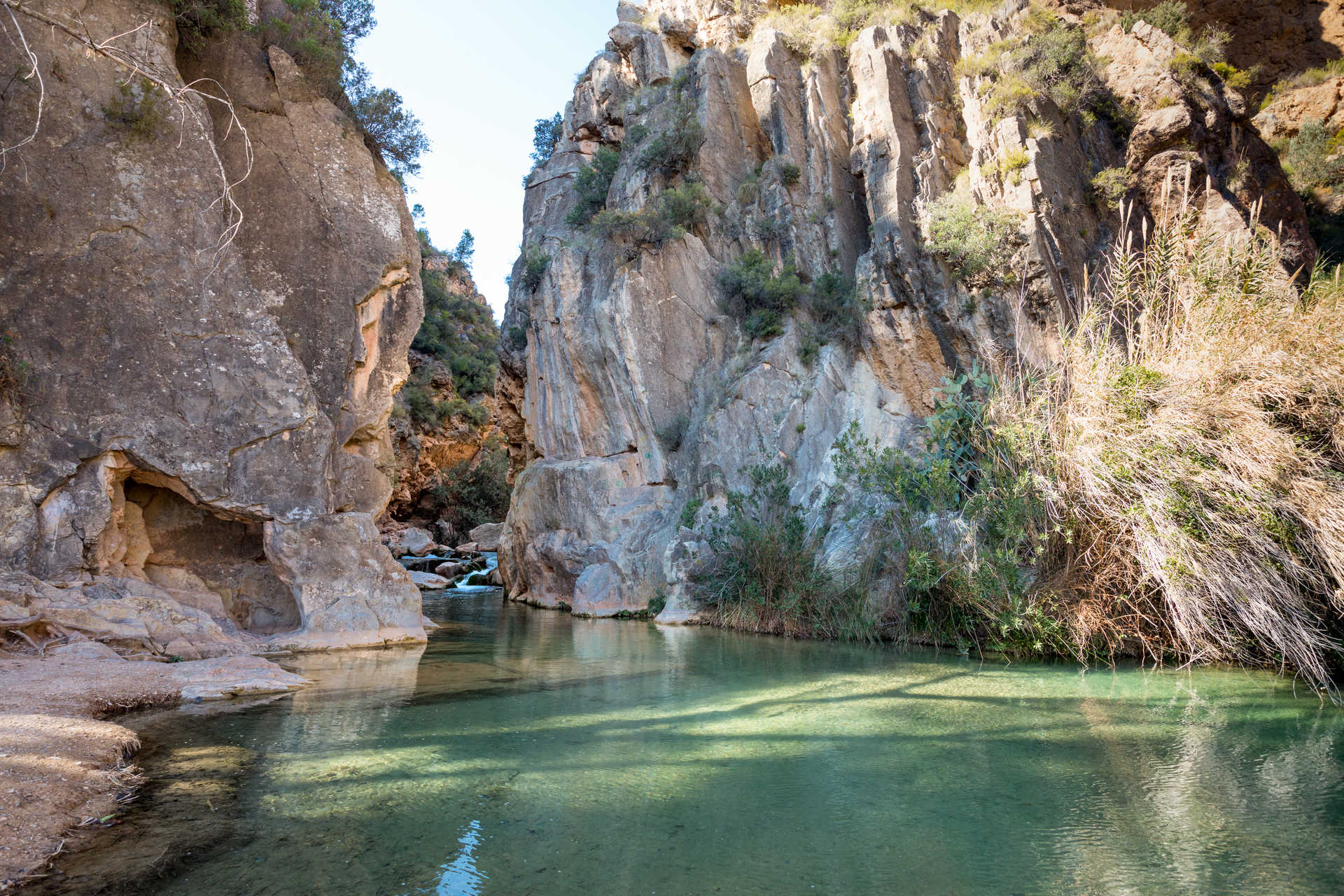
Lascia un commento